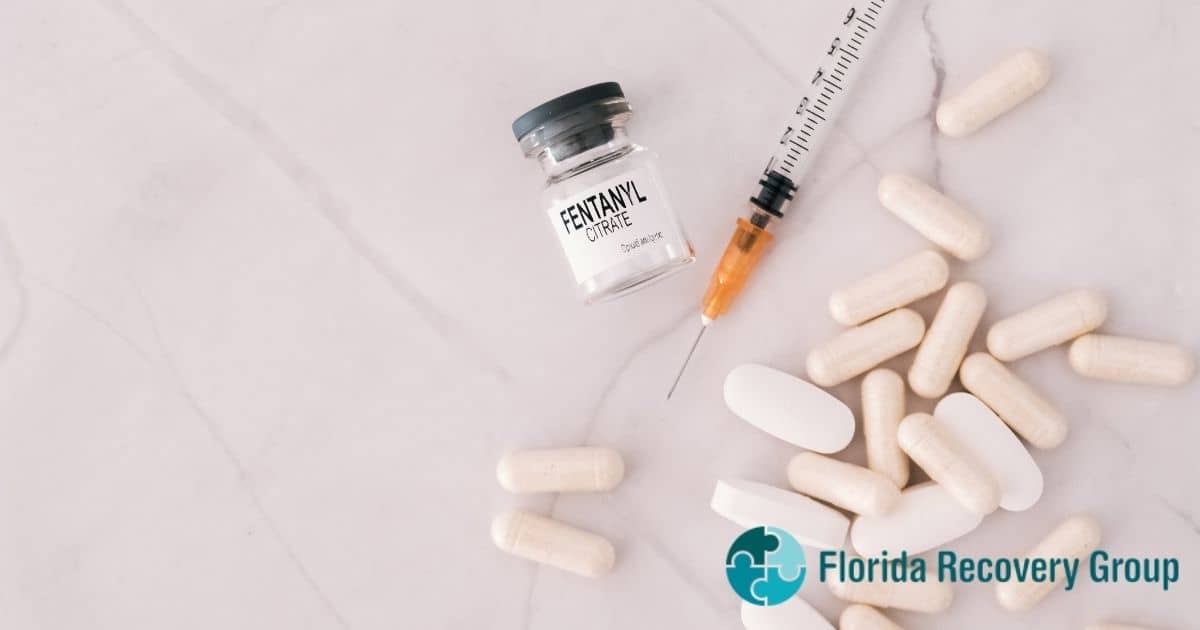
27 Dec How Long Does Fentanyl Stay in Your System?
Fentanyl is a powerful, synthetic opioid that is 50 times stronger than heroin and 100 times stronger than morphine.[1] It is sometimes used to treat severe pain after surgery or to help manage pain in patients fighting cancer. However, it has also infiltrated the illegal drug supply in the United States. It has been found in other opioids like fentanyl, counterfeit prescription pills like Xanax, and, in some cases, even laced in marijuana. The drug has also been responsible for a significant increase in the number of opioid overdose deaths over the last couple of years.[2]
Fentanyl abuse is dangerous and deadly. Even the smallest amount of this white powder can lead to a fatal overdose. Understanding how long fentanyl stays in your system can help you use substances more safely, avoid life-threatening drug interactions, and regulate your fentanyl use.
How Long Do The Effects of Fentanyl Last?
Fentanyl in patch form can last for nearly 72 hours.[3] However, most people who abuse fentanyl are not using the transdermal patch. They are abusing illegally manufactured fentanyl (IMF).[1] People who abuse illicit fentanyl may smoke, snort, or inject the drug. Any of these methods of administration can produce opioid-like effects within minutes. The effects can last for an hour or more depending on how much fentanyl was taken and how high your tolerance is when you use the drug.
How is Fentanyl Metabolized?
Fentanyl enters the bloodstream, circulates throughout the body, and ends up in the liver where it is metabolized.[4] The liver metabolizes fentanyl and leaves behind traces of the drug known as metabolites. Metabolites remain in your system longer than the actual substance does, so fentanyl can be detected in your system even after the effects of the drug wear off.
The elimination half-life refers to how long it takes half of a single dose of fentanyl to leave your body. The half-life of fentanyl varies depending on the method that is used to administer it. When injected into the bloodstream, fentanyl has a short half-life of just 2-4 hours in adults. Since it takes 4-5 half-lives for a substance to leave your body completely, it takes approximately 11-22 hours to leave your system if you inject it.
However, if you use a transdermal patch or a fentanyl lozenge, the half-life increases to 7-17 hours.[5] This means it can take fentanyl more than 36 hours to leave your system. Even when fentanyl is fully metabolized and eliminated, traces of metabolites are left behind that can be detected by various types of drug tests.
Factors That Affect Fentanyl Detection Time
The rate at which fentanyl is metabolized will affect how long the drug can be detected in your system. However, there are many individual factors that influence how fast your body metabolizes the drug. These factors include:
- The dose consumed
- Medical history
- Health conditions
- Mental health conditions
- Method of administration (i.e. snorting, injecting, smoking, or subdermal patch)
- Duration and frequency of fentanyl use
- Whether or not fentanyl was used with other substances
How Long Fentanyl is Detected in Your System: Urine, Blood, Saliva, and Hair
Most standard drug tests do not screen for fentanyl or its metabolite, norfentanyl. However, advanced chromatographic and mass spectrometry tests can reveal fentanyl and its metabolites in your system for various lengths of time.
- Urine tests – you may test positive for fentanyl on a urinalysis for 1-3 days after your last dose.
- Blood tests – blood tests may detect fentanyl in your blood between 5 and 48 hours after your last dose.
- Saliva tests – your saliva may test positive on a drug test for 1-3 days after your last dose.
- Hair follicle tests – hair follicle testing can detect fentanyl for up to 3 months (90 days) after your last dose.
If you have used a fentanyl patch, the drug may be detectable in your urine and blood for an extended amount of time.
How to Get Fentanyl Out of Your System Safely
Quick tips like exercising more, drinking lots of water, or drinking a detox smoothie will not help you eliminate fentanyl or other opioids from your system any faster. And, if you are addicted to fentanyl, you will experience flu-like withdrawal symptoms shortly after you stop using the drug. As a result, the safest way to detox from fentanyl is to do so at a medical detox facility.
Medical detox facilities offer continuous monitoring, support, and medication management. These programs can help you manage your withdrawal symptoms, cope with cravings, avoid relapse, and begin your recovery journey.
Remember, fentanyl is powerful, addictive, and deadly. Without professional help, this drug is likely to not only significantly impact your well-being, but cause you to overdose.
If you are trying to flush fentanyl from your system because you suspect you have taken too much of it, seek medical attention immediately. You should not wait until you are at risk for respiratory depression or overdose.
Help for Fentanyl Abuse and Addiction
If you or a loved one are addicted to fentanyl or any other opioid, you shouldn’t delay getting help. Continuing your addiction could lead you to an overdose, or even worse, death. Don’t wait any longer. Call now to speak with one of our dedicated addiction specialists about getting the help you deserve.
References:





